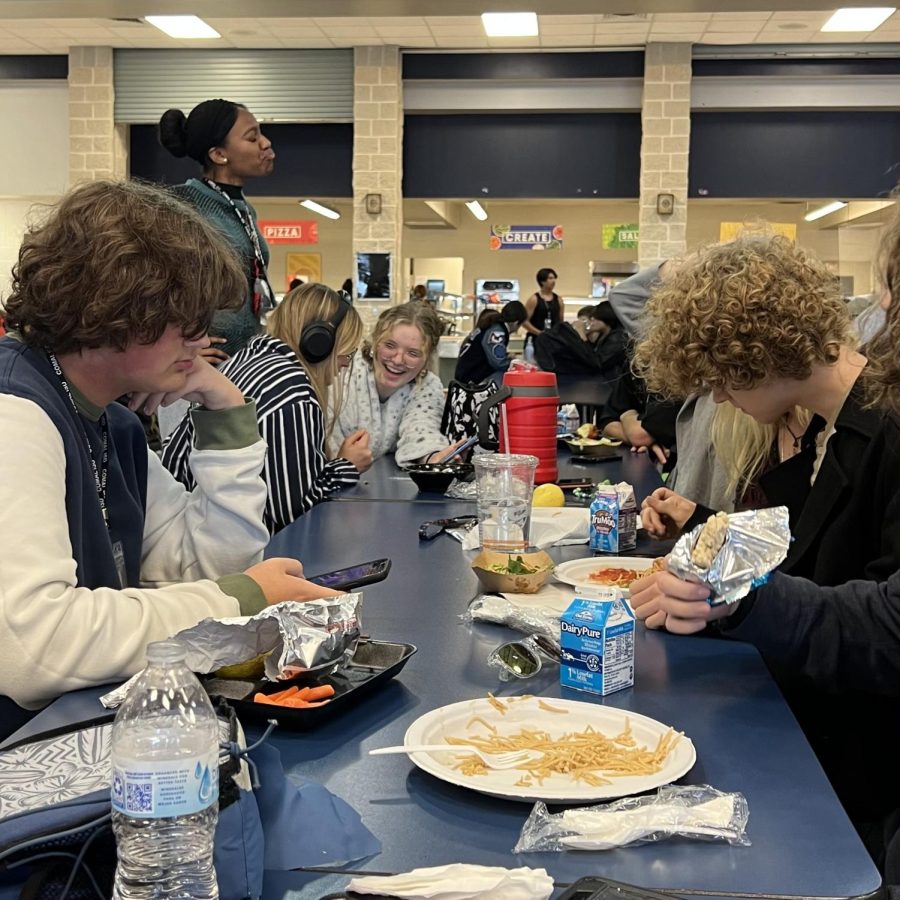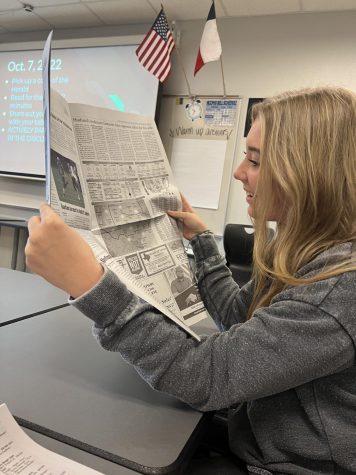A School Divided
Juniors eating lunch together is a common sight in the cafeteria. In fact, most of the grade levels split in these common areas and even in the classrooms that are blended grade levels. Our goal is to bridge these gaps existing within the student body.
October 28, 2022
HCCPHS is known for its familial feeling and revered for how connected the students are with peers and teachers alike. However, many people feel there is a deep divide between the different grade levels.
Mrs. Jones, the AP art teacher, has two different multi-level classes and has seen the divide too, stating that the different grades tend to stick together. She is concerned about the seemingly concrete separation and is trying to get the grade levels to connect more than before.
Jones is planning assignments that will help students get out of their comfort zone and collaborate with people outside their ordinary group. Hopefully, these interactions encourage collaboration that will push the connection further. However, the AP Studio Art curriculum does not leave much room for leisure, and Jones feels this attempt may not be enough.
Before these attempts by Jones and other teachers’ team-building activities, students were connected by clubs or a rare surface-level friendship.
“As teachers, can we facilitate [multi-grade level interactions]? Yes,” Mrs. Fey said. “Can we force a relationship that is too difficult to create if you’ve got a very resistant student? You can’t force that.”
In the end, it is up to the students to foster that family feeling.
“Even though I have classes with [students in other grades], I feel more interaction with the juniors and the ones that are my age,” junior Garret Domm said.
Even with interlevel classes, the connection will not grow because the students are unwilling to collaborate with students in other grades.
“It’s not anyone’s fault the school is dividing but our own, and we should put more effort into blurring the division,” sophomore Thomas Trevino said.
The number of classes the grades have together may not have anything to do with the divide, but more so the attitudes and efforts students put into making connections with each other.
As our school grows, it’s becoming harder to connect. The students have yet to make the necessary changes to our practices to accommodate new students. Every person should take a more active role in the inclusion of others, as faculty and administrators alone cannot create the family feeling we strive for on this campus.









Eli Lucas • Nov 15, 2023 at 12:55 am
The way I see it as a freshman, I think there’s a change that happens in someone’s mind when they go from a sophomore to a junior which makes them less likely to talk to lower grade levels. I assume this is the case since junior year is when you actually start to feel like an adult, whether it be because you can finally have a drivers license or because you’re having to actually consider aspects of your future such as your career or college. The reason why I think the is relevant is because since it encapsulates a junior/senior’s life, it’s what they want to talk about. This creates a divide because freshmen and sophomores don’t think/talk about this kind of stuff and if they do, it’s not in the same way that a junior or senior would. I actually have some anecdotal evidence of this exact situation.
For privacy reasons, I won’t state any of the student’s names, just the grade levels. There was this day when me and one of my group members (a junior) went to the Falcon Peak to practice presenting for a project. A little later another group came in which was composed of just a junior and someone who’s either a junior or sophomore. After some time, our groups combined and the two juniors started talking about relationships and going into how they don’t know how they’re going to handle their relationship after high school. The thing is, it was really just them talking. I didn’t jump in because I don’t have to think about that stuff currently, and also because I’m not in a relationship so I can’t relate at all, and the other person only said a few quips and that was it. That very last part was hyperbolized but regardless, this is a clear example of the divide between grade levels, though I do have some suggestions on how this can be fixed.
The clearest way in my opinion to fix this would not be to force people together, similar to what Mrs. Fey said, but to encourage the idea of these relationships between grade levels. Exact ways to do this heavily depend on the class itself and the material being taught, but if the teachers can come up with a way to do this, I feel like it will not only help decrease this divide, but also increase the knowledge of lower grade levels through learning what the juniors and seniors think about.
Off topic: I know this article was made before I even got to this campus, but I believe that commenting on it now is a good time. This is because it’s the 2nd nine weeks of the first year to have seniors which has given enough time to see a divide. From what I see, there is way less of a divide than what is being described here but you can still see one. From exactly what I’ve noticed and what I kind of alluded to in the beginning, there is really only a divide between freshmen/sophomores and juniors/seniors. Also I know that it’s midnight. My excuse is that I took a 2 hour nap at 9:00 PM
Xavier Powell • Mar 10, 2023 at 12:00 pm
I think the main reason for the division grade levels is lack of overlap in classes for example my P.E. class is the only class i have that is not only freshmen.
Kai Anderson • Oct 31, 2022 at 3:25 pm
I love Fortnite and this article.